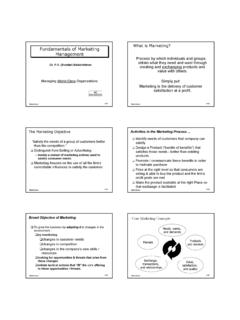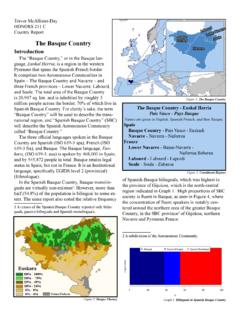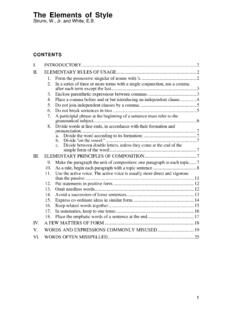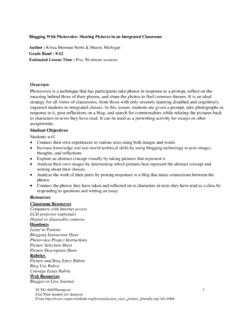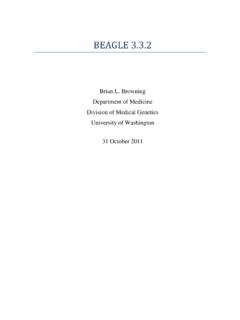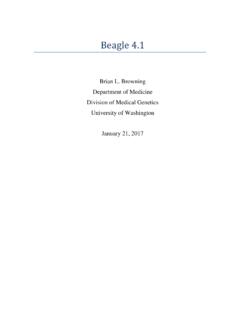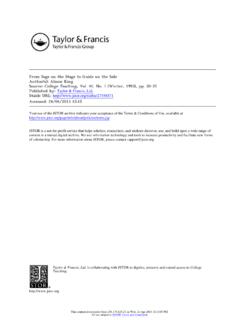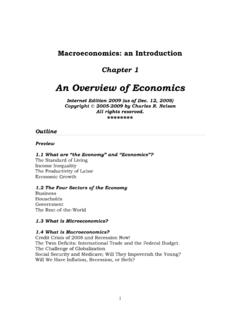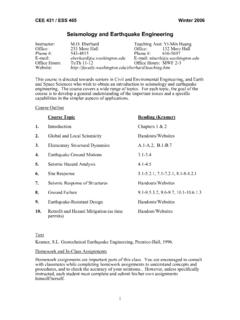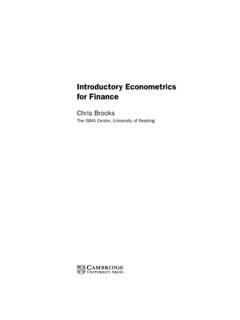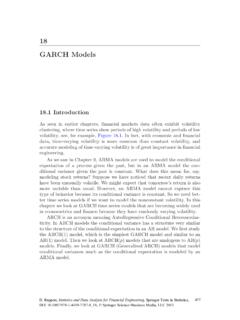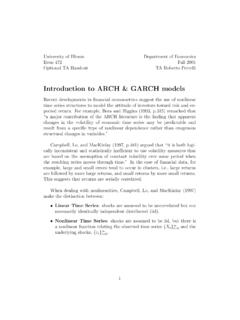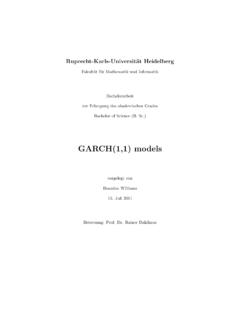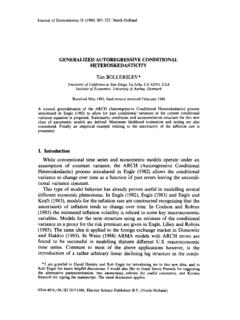Transcription of Introduction to the rugarch package. (Version 1.0-14)
1 Introduction to the rugarch package.(Version )Alexios GhalanosJanuary 13, 2013 Contents1 Introduction32 model Univariate ARFIMAX Models .. Univariate garch Models .. standard garch model ( sGARCH ) .. integrated garch model ( iGARCH ) .. exponential garch model .. GJR- garch model ( gjrGARCH ) .. asymmetric power ARCH model ( apARCH ) .. family garch model ( fGARCH ) .. Component sGARCH model ( csGARCH ) .. Conditional Distributions .. Normal Distribution .. Student Distribution .. Generalized Error Distribution .. Distributions by Inverse Scale Factors .. Generalized Hyperbolic Distribution and Sub-Families .. Generalized Hyperbolic Skew Student Distribution .. s Reparametrized SU Distribution ..193 Fit Diagnostics ..224 Filtering265 Forecasting and the garch Bootstrap276 Simulation297 Rolling Estimation308 Simulated Parameter Distribution and RMSE339 The ARFIMAX model with constant variance38110 Mispecification and Other The GMM Orthogonality Test.
2 Parametric and Non-Parametric Density Tests .. Directional Accuracy Tests .. VaR and Expected Shortfall Tests ..4111 Miscellaneous Functions4212 Future Development4213 FAQs and Guidelines4221 IntroductionThe pioneering work of Box et al. (1994) in the area of autoregressive moving average modelspaved the way for related work in the area of volatility modelling with the Introduction of ARCHand then garch models by Engle (1982) and Bollerslev (1986), respectively. In terms of thestatistical framework, these models provide motion dynamics for the dependency in the condi-tional time variation of the distributional parameters of the mean and variance, in an attemptto capture such phenomena as autocorrelation in returns and squared returns. Extensions tothese models have included more sophisticated dynamics such as threshold models to capturethe asymmetry in the news impact, as well as distributions other than the normal to accountfor the skewness and excess kurtosis observed in practice.
3 In a further extension, Hansen (1994)generalized theGARCH models to capture time variation in the full density parameters, withthe Autoregressive Conditional Density Model1, relaxing the assumption that the conditionaldistribution of the standardized innovations is independent of the conditioning aims to provide for a comprehensive set of methods for modelling uni-variateGARCH processes, including fitting, filtering, forecasting, simulation as well as diagnostictools including plots and various tests. Additional methods such as rolling estimation, boot-strap forecasting and simulated parameter density to evaluate model uncertainty provide a richenvironment for the modelling of these processes. This document discusses the finer details ofthe included models and conditional distributions and how they are implemented in the packagewith numerous forms part of the rgarch project on also includes thermgarchpackage for multivariateGARCH models.
4 Previously, bothunivariate and multivariate models were included in one large package which was split for releaseto CRAN in August package is provided AS IS, without any implied warranty as to its accuracy or lot of time and effort has gone into the development of this package, and it is offered under theGPL-3 license in the spirit of open knowledge sharing and dissemination. If you do use the modelin published work DO remember to cite the package and author (typecitation( rugarch ) forthe appropriate BibTeX entry) , and if you have used it and found it useful, drop me a note andlet me section on FAQ is included at the end of this model SpecificationThis section discusses the key step in the modelling process, namely that of the is defined via a call to theugarchspecfunction,> args(ugarchspec)function ( = list( model = "sGARCH", garchOrder = c(1,1), submodel = NULL, = NULL, = FALSE), = list(armaOrder = c(1, 1), = TRUE,archm = FALSE, archpow = 1, arfima = FALSE, = NULL,archex = FALSE), = "norm", = list(), = list().)
5 NULL1 This may be included in the package at a future a model , in therugarchpackage, may be described by the dynamics of the conditionalmean and variance, and the distribution to which they belong, which determines any additionalparameters. The following sub-sections will outline the background and details of the dynamicsand distributions implemented in the Univariate ARFIMAX ModelsThe univariate garch specification allows to define dynamics for the conditional mean fromthe general ARFIMAX model with the addition of ARCH-in-mean effects introduced in Engleet al. (1987). The ARFIMAX-ARCH-in-mean specification may be formally defined as, (L)(1 L)d(yt t) = (L) t,(1)with the left hand side denoting the Fractional AR specification on the demeaned data and theright hand side the MA specification on the residuals. (L) is the lag operator, (1 L)dthe longmemory fractional process with 0< d <1, and equivalent to the Hurst ExponentH- , and tdefined as, t= +m n i=1 ixi,t+m i=m n+1 ixi,t t+ kt,(2)where we allow formexternal regressorsxof whichn(lastnofm) may optionally be multipliedby the conditional standard deviation t, and ARCH-in-mean on either the conditional standarddeviation,k= 1 or conditional variancek= 2.
6 These options can all be passed via the argumentsin in theugarchspecfunction, armaOrder (default = (1,1). The order of the ARMA model .) (default = TRUE. Whether the mean is modelled.) archm (default = FALSE. The ARCH-in-mean parameter.) archpow (default = 1 for standard deviation, else 2 for variance.) arfima (default = FALSE. Whether to use fractional differencing.) (default = NULL. A matrix of external regressors of the same lengthas the data.) archex (default = FALSE. Either FALSE or integer denoting the number of external re-gressors from the end of the matrix to multiply by the conditional standard deviation.).Since the specification allows for both fixed and starting parameters to be passed, it is useful toprovide the naming convention for these here, AR parameters are ar1 , ar2 , .., MA parameters are ma1 , ma2.
7 , mean parameter is mu archm parameter is archm the arfima parameter is arfima the external regressor parameters are mxreg1 , mxreg2 , ..,Note that estimation of the mean and variance equations in the maximization of the likelihoodis carried out jointly in a single step. While it is perfectly possible and consistent to performa 2-step estimation, the one step approach results in greater efficiency, particularly for Univariate garch ModelsIn garch models, the density function is usually written in terms of the location and scaleparameters, normalized to give zero mean and unit variance, t= ( t, t, ),(3)where the conditional mean is given by t= ( ,xt) =E(yt|xt),(4)and the conditional variance is, 2t= 2( ,xt) =E((yt t)2|xt),(5)with = ( ,xt) denoting the remaining parameters of the distribution, perhaps a shape andskew parameter.
8 The conditional mean and variance are used to scale the innovations,zt( ) =yt ( ,xt) ( ,xt),(6)having conditional density which may be written as,g(z| ) =ddzP(zt< z| ),(7)and related tof(y| ) by,f(yt| t, 2t, ) =1 tg(zt| ).(8)Therugarchpackage implements a rich set of univariate garch models and allows forthe inclusion of external regressors in the variance equation as well as the possibility of usingvariance targeting as in Engle and Mezrich (1995). These options can all be passed via thearguments in in theugarchspecfunction, model (default = sGARCH (vanilla garch ). Valid models are iGARCH , gjrGARCH , eGARCH , apARCH and fGARCH ). garchOrder (default = c(1,1). The order of the garch model .) submodel (default = NULL. In the case of the fGARCH omnibus model , valid choices are garch , TGARCH , GJRGARCH , AVGARCH , NGARCH , NAGARCH , APARCH and ALLGARCH ) (default = NULL.)
9 A matrix of external regressors of the same lengthas the data). (default = FALSE. Whether to include variance targeting. It is alsopossible to pass a numeric value instead of a logical, in which case it is used for thecalculation instead of the variance of the conditional mean equation residuals).The rest of this section discusses the various flavors of garch implemented in the package,while Section discusses the distributions implemented and their standardization for use inGARCH The standard garch model ( sGARCH )The standard garch model (Bollerslev (1986)) may be written as: 2t= +m j=1 jvjt +q j=1 j 2t j+p j=1 j 2t j,(9)with 2tdenoting the conditional variance, the intercept and 2tthe residuals from the meanfiltration process discussed previously. The garch order is defined by (q,p) (ARCH, garch ),with possiblymexternal regressorsvjwhich are passedpre-lagged.
10 If variance targeting is used,then is replaced by, 2(1 P) m j=1 j vj(10)where 2is the unconditional variance of 2which is consistently estimated by its sample counter-part at every iteration of the solver following the mean equation filtration, and vjrepresents thesample mean of thejthexternal regressors in the variance equation (assuming stationarity), and Pis the persistence and defined below. If a numeric value was provided to in the specification (instead of logical), this will be used instead of 2for the of the key features of the observed behavior of financial data which garch modelscapture is volatility clustering which may be quantified in the persistence parameter P. For the sGARCH model this may be calculated as, P=q j=1 j+p j=1 j.(11)Related to this measure is the half-life (call ith2l) defined as the number of days it takes forhalf of the expected reversion back towardsE( 2)to occur,h2l= loge2loge P.
